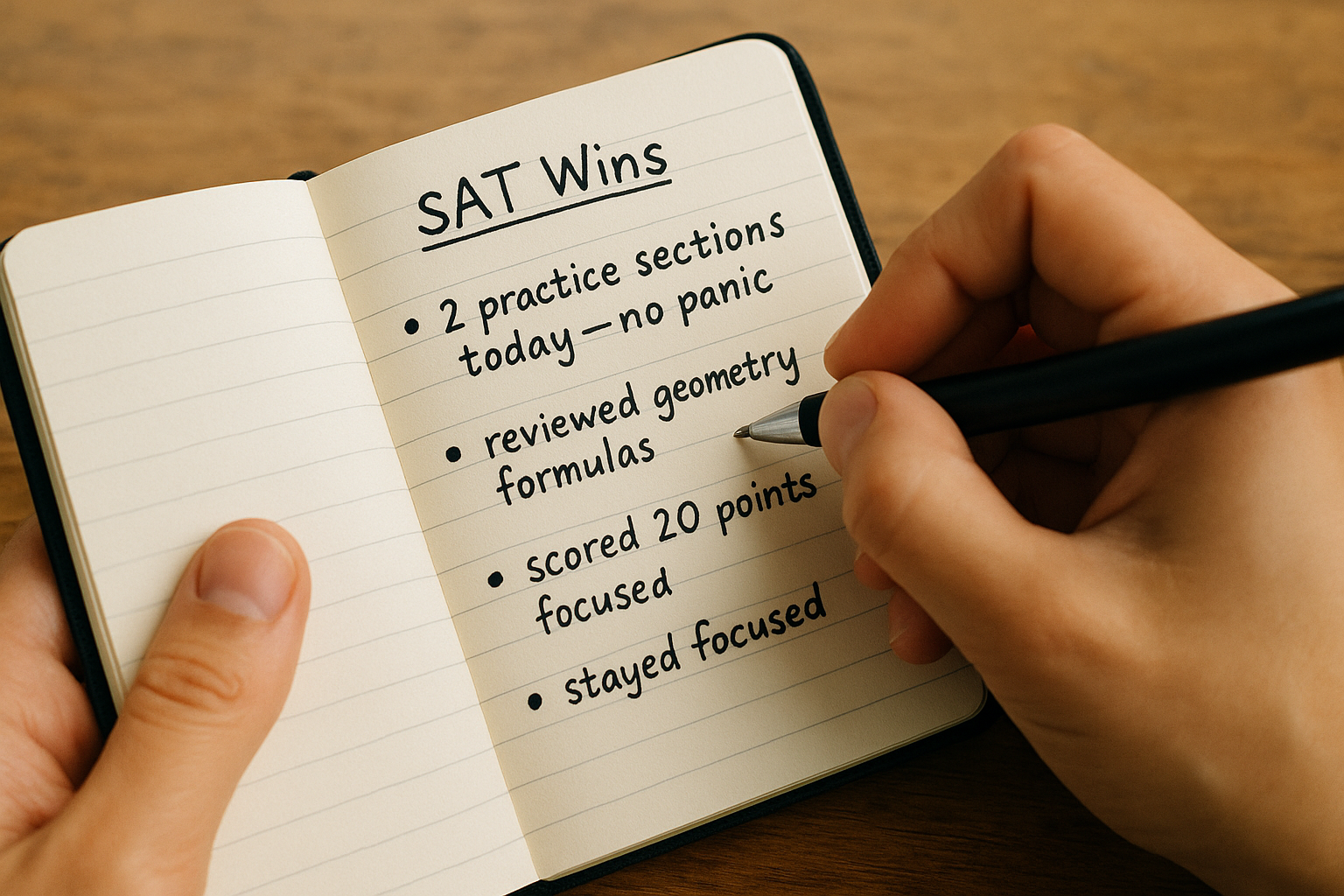Introduction: You’re Not Alone — Even If You’re the First
Being the first in your family to take the SAT feels like carrying a torch into unknown rooms. There’s excitement—because you’re opening doors—mixed with pressure, because there might not be a roadmap at home. That combo is powerful, and it can either fuel you or freeze you. The good news: confidence is a skill, not a trait you’re locked into. You can build it, deliberately and practically, with a plan that honors both your circumstances and your goals.
Why Confidence Matters for the Digital SAT
Confidence shows up in test performance in small but meaningful ways: staying calm when a question is unfamiliar, choosing to skip and come back instead of panicking, and trusting your reasoning instead of second-guessing every step. For the digital SAT, where adaptive sections and new tools change the rhythm of the test, confidence helps you adapt on the fly and use the testing app calmly and efficiently.
What confidence actually does
- Reduces time lost to anxiety and second-guessing.
- Helps you execute practiced strategies under pressure.
- Encourages consistency: confident students get more reliable results across practice runs and test day.
Step 1 — Make the Unknown Known: Learn the Digital SAT Format
Uncertainty breeds nerves. The quickest way to defuse that is by learning exactly what to expect. The Digital SAT is administered on a secure testing app, and practice tools like full-length digital practice tests let you experience the format before test day. Spend time on the testing app (Bluebook or the official practice tool) so the navigation, built-in tools, and timing become familiar.
Practical actions
- Download the official testing app and try the preview test to see the interface.
- Take at least two full-length timed practice tests on the same device you’ll use on test day.
- Practice with the same calculator and any permitted tools so you aren’t fiddling with new tech on test day.
Step 2 — Build a Realistic, Personalized Study Plan
Confidence grows from competence. But competence doesn’t come from random studying; it comes from targeted practice. If you’re the first in your family preparing for the SAT, you might not have a default study blueprint. That’s fine—design one that fits your schedule, strengths, and areas to grow.
How to create your plan
- Start with a diagnostic practice test to identify your baseline.
- Set a clear target score informed by the colleges you hope to apply to and by realistic improvement goals.
- Break your plan into weekly blocks: skill work, timed section practice, review days, and at least one full-length practice test every 2–3 weeks.
Sample 12-week study plan (overview)
| Weeks | Focus | Sample Weekly Goals |
|---|---|---|
| 1–2 | Baseline & Foundations | Diagnostic test, learn interface, target weak areas, 3 practice sessions |
| 3–6 | Skill Building | Content review (grammar, algebra, data analysis), daily short drills, 1 timed section/week |
| 7–9 | Strategy & Timing | Tactics for adaptive sections, pacing practice, 1 full-length test every 2 weeks |
| 10–11 | Polish & Simulation | Full-length tests weekly, analyze mistakes, light content review |
| 12 | Rest & Final Prep | Light review, practice test if confident, sleep and logistics check |
Step 3 — Use Smart Practice Tools (Not Just Hours)
Clocking time is necessary, but it’s the quality of practice that moves the needle. Focused practice—working on the exact skill that limits your score—is far more effective than putting in hours of unfocused review.
High-leverage practice methods
- Active review: After each missed question, write out why you missed it and how to avoid that mistake next time.
- Spaced repetition: Return to problem types you struggled with at increasing intervals.
- Simulated conditions: Take practice sections with realistic timing and minimal interruptions.
If building a study routine by yourself feels overwhelming, personalized tutoring can help. Sparkl’s personalized tutoring offers 1-on-1 guidance, tailored study plans, and expert tutors who can translate your diagnostic into a step-by-step path. When support matches your learning style, practice becomes less intimidating and more strategic.
Step 4 — Build Small Wins to Grow Big Confidence
Confidence grows from a chain of small successes. Aim for mini-goals and celebrate them. Those victories build a psychological reservoir you can draw on when the pressure spikes.
Examples of small wins
- Improve your accuracy on algebra problems from 60% to 75% in two weeks.
- Complete a timed reading passage without running out of time.
- Reduce careless errors by keeping an error log; show progress over three practice sessions.
Step 5 — Practice Test-Day Routines and Logistics
Sometimes confidence cracks not because you don’t know the content, but because you forgot a charger, or arrived stressed from a rushed morning. Create a test-day checklist and rehearse it.
Test-day checklist
- Device fully charged, with Bluebook app updated and tested.
- Approved photo ID and admission ticket printed or readily accessible.
- Comfortable clothes, snacks for before/after (not during), and extra time to get to the test center.
- Relaxation plan: 5–7 minutes of deep breathing before you start each section.
Rehearse this routine on the day of a full-length practice test so it becomes second nature. When a procedure is automatic, your mental energy stays free for the questions themselves.
Step 6 — Manage Mindset: From Pressure to Purpose
Being the first in your family to take the SAT can feel like more than a test—it can feel symbolic. That weight can be motivating, but it can also feel crushing. The goal is to convert pressure into purpose.
Mindset shifts that help
- From “I must not fail” to “I am giving my best effort with the tools I have.”
- From “This defines me” to “This is one piece of my application and my story.”
- From “I’m alone” to “I am leading a path for myself and others; help is available.”
Small rituals—like a 3-minute breathing exercise or a short pep talk before a practice test—are simple ways to anchor a calm, purposeful mindset. Journaling about small improvements each week also turns diffuse anxiety into measurable progress.
Step 7 — Use Community & Mentors: You Don’t Have to Invent Everything
First-generation students sometimes lack direct family experience with standardized testing, but you can expand your support network in other directions. Counselors, teachers, peers, online communities, and tutors can become your advisory circle.
Who to reach out to and how
- School counselors: Ask for mock tests, fee-waiver information, and application guidance.
- Teachers: Request targeted review or short recommendations for improvement.
- Peers: Form a small study group to quiz each other and share strategies.
- Tutors or coaching programs: If you want structured accountability, consider a tutor who will build a tailored plan and keep you on track; for many students, Sparkl’s tutors provide expert guidance plus AI-driven insights to target weak areas efficiently.
Step 8 — Translate Practice Gains into Test-Day Confidence
After weeks of practice, you might still feel anxious before the actual test. The trick is to translate accumulated preparation into a mental script you can run on test day. Remind yourself of the evidence: practice scores, consistent improvements, and mastered strategies.
A short test-day script
- Before you start: “I’ve practiced under test conditions and proven I can handle this.”
- If you hit a hard question: Take a breath → mark and move on → return if time allows.
- When fatigue sets in: Slow down for one minute and refocus on technique, not on the score.
Common Challenges and How to Handle Them
We won’t sugarcoat it: you’ll run into setbacks. The difference between students who crumble and those who grow is how they respond.
Challenge: I’m not improving fast enough
Try diagnosing the root cause. Are you practicing the wrong thing, repeating the same mistakes, or not reviewing explanations? Use a targeted plan that focuses on the limiting factor—not just the easiest tasks.
Challenge: I feel isolated at home
Build an external support system. Join study groups, connect with a counselor, or arrange regular tutor check-ins. If affordability is a concern, ask your school about fee waivers or community-based programs that offer test prep support.
Challenge: Test anxiety flares up on the day
Use immediate calming practices: remove yourself for a brisk walk before the test block, use grounding techniques (5 things you can see, 4 you can touch, 3 you can hear), and remind yourself that one test won’t erase your full potential.
Real-World Context: Why Being First Is a Strength
First-in-family test-takers often develop unique strengths: resourcefulness, persistence, and an ability to translate scarce resources into outcomes. These qualities matter in college and beyond. Your journey demonstrates initiative and resilience—qualities that admissions officers and scholarship committees value, and that will serve you long after the score arrives.
Practical Resources to Use (What to Practice and Where)
- Official practice tests in the testing app: simulate test-day conditions.
- Targeted question banks: build skill-specific drills for grammar, algebra, and data interpretation.
- Timed sections: practice pacing by doing single sections under test timing, then review every mistake immediately.
If you want structured, personalized help, consider options that combine human tutors with data-driven insights. Sparkl’s approach pairs 1-on-1 tutoring with tailored study plans and AI-driven insights to focus your work efficiently and track improvement over time—helpful for students who want a clear roadmap and consistent accountability.
Measuring Progress: What Success Looks Like
Success isn’t only the final score. Measure progress with both quantitative and qualitative markers:
- Quantitative: improvement on timed practice tests, reduced error rate in specific question types, or moving closer to your target score.
- Qualitative: increased calm during practice tests, fewer panic moments, and an ability to correct mistakes on your own during review sessions.
Putting It All Together: A Week-by-Week Confidence-Building Routine
Below is an example week during the middle of a 12-week plan. The key is balance—skill work, strategy, mock practice, and rest.
| Day | Activity | Purpose |
|---|---|---|
| Monday | 45-minute algebra drills + error log | Skill building |
| Tuesday | Timed Reading section (digital) | Pacing practice |
| Wednesday | Grammar review + 30-minute mixed questions | Content consolidation |
| Thursday | Rest or light review (flashcards) | Mental recovery |
| Friday | Full-length practice test (digital) | Simulation |
| Saturday | Review test mistakes with tutor/peer | Active learning |
| Sunday | Plan next week + light reading | Preparation & rest |
Stories of Progress: Small Examples, Big Meaning
Imagine a student who started with a practice score well below their target and found that their biggest barrier was careless arithmetic mistakes. They kept an error log and adjusted their approach: slow down on the first read, estimate before calculating, and double-check only the highest-impact problems. Over eight weeks their math accuracy climbed, and more importantly, they felt calmer on timed sections because they had a reliable routine. That feeling translated into better focus and a higher score.
These small, practical shifts are what build lasting confidence. They don’t require perfect conditions—just consistency and reflection.
Final Encouragement: Your Role Is Not Just About Scores
Being the first in your family to take the SAT is meaningful beyond a test result. It’s about charting a path, creating options, and modeling courage. You’ll learn planning, persistence, and how to ask for help—all skills that are valuable regardless of the exact number on the score report.
Choose the next right step—whether it’s taking a practice test this weekend, creating an error log, asking a teacher for one-on-one clarification, or booking a session with a tutor to make a targeted plan. Small, consistent steps will accumulate into real readiness and a deep sense of capability.
One last practical tip
Before any practice test or the real thing, write down two things you did well in your last study session and one thing you want to improve. It keeps your mindset growth-oriented and your priorities clear.
Where to Go From Here
You don’t have to do this alone. Use official digital practice tools to get comfortable with the format, create a study plan that matches your life, and seek focused support when you need it—whether from a counselor, teacher, peer group, or a personalized tutoring service like Sparkl that combines 1-on-1 guidance, tailored study plans, and AI-driven insights to help you work smarter, not just harder.
Take a breath. Take a practice test. Take another small step tomorrow. Confidence is built one clear, intentional action at a time—and you’re already on the right path.
















No Comments
Leave a comment Cancel